
|   |

|   |
Gently flows the Sindhu - Veejay Sai e-mail: vs.veejaysai@gmail.com Pics courtesy: Sindhu Dance Festival April 29, 2013 Mumbai, the city of big dreams and high hopes for those smitten by Bollywood and Hindi television might not be the most sought after destination for Indian classical dancers. But over the decades, thanks to the persistent efforts of several gurus and dance-enthusiasts, the city has grown to be an important center for students of dance. Gurus like Kalyanasundaram Pillai and Dr Kanak Rele have been doing yeoman service to dance for several decades now, far away from the epicenter of Chennai sabhas. While everyone is well aware of the National Center for Performing Arts and its programming of various dance recitals , the Nalanda festival for young dancers conducted by Dr Kanak Rele and a few on and off events, the latest feather in Mumbai’s cultural cap is the Sindhu Dance Festival conducted by young dancer and guru Vaibhav Arekar. What started last year as a tribute to his late mother, in a small way blossomed into a noteworthy festival in just one year. This year the Sindhu festival turned out to be a blockbuster hit among audiences who arrived in large numbers, craving for some good cultural overhaul. Day 1: Abhinaya encore! The first evening was inaugurated at the Mysore association with an exclusive evening of abhinaya by two veteran dance gurus - Uma Dogra, Mumbai’s very own representative of the Jaipur Gharana of Kathak, and senior Bharatanatyam exponent Guru CV Chandrashekar. As the performance began with melodious strains of the sitar by Bhupal Panshikar and a soulful aalap on the sarangi by Farooq, Uma commenced her presentation with an invocatory Shivapanchakshari Stotram sung by the talented Manoj Desai. While it was certainly refreshing to see Uma performing, one could sense the visible fatigue in her as she couldn’t keep up with the rhythm at various stances. Following that was a Meera Bhajan “Baso more nainan me nandlal,” where Uma displayed the vatsalya rasa. Depicting the acts of mother Yashoda bathing a little Krishna in her lap, she gave a complete oil massage. One could literally imagine a baby being fondled with her nimble hands. After that came her main item, a wonderful thumri “Dagar bich kaise chalu, math thado kanhaiya” evoking shringaar rasa. This was easily her best presentation. Interspersing the traditional composition with poems by Kanupriya, which seemed to effortlessly fit into the theme, Uma exhibited her fine artistry in depicting shringaar rasa. While the poetry was certainly worth fitting into, it was barely audible with the singer Indrani Mukherjee mumbling into the mic. From such a sublime piece, Uma decided to depict abhinaya for a ghazal she wrote. She also proudly announced that she had written it only two days ago and it was tuned in no time by Manoj. What started off with “Kuch kehti hain khaamoshiyaan, kuch udaas si lamhe, Guzar rahi raat hain, Hai tere gham me,” ended up like a badly written Hindi film song from a 70’s flick. Uma was attempting to portray a Virahini nayika but neither did the mood come through nor did the music make up for it. There was no sense of proportion in the language of the ghazal either. From Urdu to prosaic Hindi, everything was used, making it a mish-mash totally bereft of the needed pathos. One wished she had stuck to a more traditional piece to portray her abhinaya. She ended her performance with a pure dance sequence set to nine matras that was sub-divided into three matras each with the samm landing on the sixth. Once again it was a pleasure to watch her footwork which seemed to have warmed up by now. 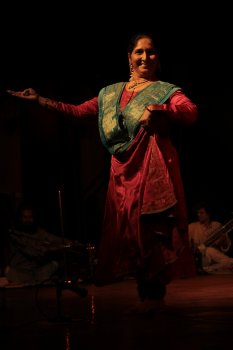 Uma Dogra 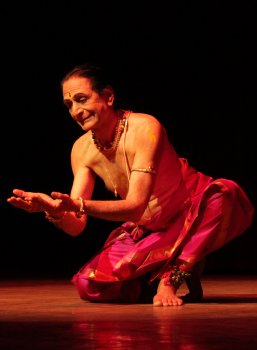 Guru C V Chandrashekar The second half of the evening was a solo performance by guru C V Chandrashekar. Fondly addressed as ‘Chandru Anna’, he not only gave a stellar performance but also had the entire packed hall wanting for more! He commenced his performance with a shloka in Arabhi ragam and continued that into Tyagaraja’s famous kriti “Ksheerasagara shayana” in Devagandhari ragam. It was a delight to see his interpretation of scenes from the Gajendra Moksham and Draupadi Vastrapaharanam rendered in a rather unusual style with his fine abhinayam. The rasa expressed through CVC’s eyes was a sight to see, especially in the Gajendra Moksham sequence, continuing into a thematic presentation based on the genre of Tamil poetry called ‘Pillai Tamil,’ the foremost poets of who was Kumaraguruvara, the founder of the Kasi Mutt. Narrating the pranks of a playful child Kumara and his tantrums on his father Shiva, CVC’s selection was refreshing. For those male dancers who complain of having to repeatedly portray nayikas, this is a piece worth watching and learning. A special mention must be made of vocalist Hariprasad whose melodious voice transported everyone in the sabha to a different world altogether. He is easily one of the finest singers for Bharatanatyam we have anywhere in India. CVC also announced that this was his first ‘only abhinaya’ performance in his whole career and going by his performance, the whole hall was thankful to Vaibhav for conceptualizing this wonderful evening. From the portrayal of a nayika’s longing in the padam “Daadi Joochutunnadi” set to ragam Shankarabharanam, a composition of Muvaloor Sabhapatayya to the javali “Entati kuluke” set to Kalyani ragam, CVC’s effortless exhibition reflected on his decades of intense sadhana as an artiste. Earlier in the performance, he had announced to present an Ashtapadi which he seemed to have completely forgotten. As he took the mic to announce his last item, a Thillana, a racket in the audience with rasikas demanding the forgotten Ashtapadi reminded the guru and beckoned him back. Portraying the viraham of Krishna in “Maameyam chalita vilokya,” CVC’s abhinaya was once again a stellar performance. The finale, a Thillana he composed as a tribute to the lord of Kashi was once again a refreshing piece. Set to a nine-beat rhythm, Khandajaati triputa taalam, this Thillana in Hamsanaadam showed what a fine composer CVC is. By the time the mangalam was underway, CVC was received with a standing ovation by a packed hall. In the audience was the who’s who of Mumbai’s dancer community. From veteran Guru Kalyanasundaram Pillai and senior Kalakshetra alumni Uma Devi to gurus like Chhaya Khanvate and Uma Dogra, from Ratikant Mohapatra to the many students of all the dance schools, one could see a glow on their faces. The first day of the Sindhu Festival ended on a highly energetic note with everyone returning with the wonderful gift of abhinayam in their mind. Day 2: Of sarcastic lovers and more The second day of the Sindhu Festival, the venue shifted to the Ravindra Natya Mandir in the heart of Mumbai. The evening’s first performance was a Kathak ensemble called Beej headed by Sanjukta Wagh accompanied by dancers who had been trained under Rajashree Shirke. They performed ‘Seeking to Embody’, a piece choreographed around the famous Kabir bhajan. The piece failed to strike a note with the whole group putting up a rather bland performance. Except for Sanjukta, who outshone others, the rest of the dancers did whatever they wanted to in totally unsynchronized presentation. Added to this was the besuraa voice of the singer on record. They continued their performance with ‘Avartan,’ a pure dance sequence in teentaal, chakkars attached, which turned out to be rather monotonous. The only saving grace was the thumri in raag Pilu, a composition of Maharaj Bindadin, portraying the pranks of Lord Krishna and gopis. Following that was the famous Kabir Bhajan “Sunta hain guru gyaani” sung by Pt Kumar Gandharva. While the treatment of the slow dance went well with the wonderful music, the end became unnecessarily funny. After such a deep philosophical meandering, the swan turned into a train and kept going as the dancers wouldn’t stop their footwork, spoiling what could have been an otherwise wonderful choreographic idea. 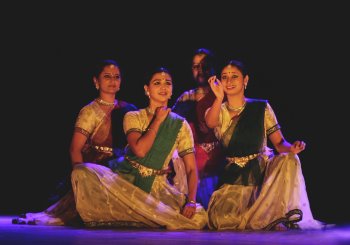 Beej 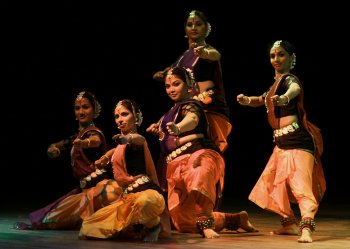 Sankhya The second presentation for the evening titled ‘Postcards from Sankhya’ was Vaibhav Arekar’s very own troupe performing. Performing to recorded music, they began with a pushpanjali sung by OS Arun. A piece on the seasons turned out to be less serious than it should have been. While Vaibhav was right in where he was, an extremely plump dancing partner made his whole presentation lose its seriousness. Using motifs of tribal music to portray summers was a good idea but the choreography in itself stood out disconnected to the whole piece. At the most, it became an experimental patchwork, certainly not worth a festival standard. A piece titled ‘Astitva’ followed with pseudo-ballet movements set to rather loud music. The show ended with a jugalbandi of Beej and Sankhya dancers performing the Dwadasha Jyotirlinga Stotra followed by ‘Kasturi Tilakam’ in raag Madhuwanti. All the presentations seemed to be done in an extreme hurry so much so the last piece had a totally besuraa flute envelope the auditorium, much to the discomfort of the rasikas. 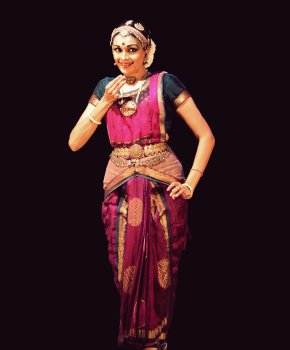 Priyadarsini Govind
The finale of the second day was the much-awaited solo Bharatanatyam presentation by Priyadarsini Govind. Opening with an invocation to the mother goddess with music set in a Ragamalika and a Taalamalika by Rajkumar Bharathi, one saw Priya slowly twirl her movements to display the Saptamatrikas. With selections from the Rajarajeshwari Stotram, Ardhanareeshwara Stotram, Annapoorna ashtakam and other traditional compositions in praise of the Devi, Priya began her performance with much energy. However the Ragamalika with so many ragas in it made a little sense beyond it being a patchy work. with neither a skeletal structure of a common theme running through, added to Nandini Anand who kept singing “Vara Bhayakari” (completely changing the meaning of that line!), the slow footwork of Priya was marred with an imposing silhouette of hers thrown in the background by a distracting footlight. While the initial effect of the shadow was good, it became an overkill to have that followed in every other sequence. Priya continued into the main piece, a Dhandayudhapani Pillai’s padavarnam in ragam Karaharapriya set to adi talam. The first half of the Varnam portrayed a Khandita nayika and the second part, the nayika turned into a Swadheena Pathika. An excellent violin prelude by Easwar Ramakrishnan set the ambience for the nayika to explore. Priya’s depiction of the tormented nayika being mocked by the moon in the lines “Moham aginen inda velayil” was excellent. However in the second half, the singer seemed totally disconnected with the dancer on stage. As Nandini’s voice soared beyond the tolerable decibels in the hall, Priya’s dance was busy portraying something else on stage. The best piece was the third one where Priya presented exemplary abhinayam to the famous Kshetrayya padam “Inta moham yemiraa” set to ragam Shankarabharanam and trisra triputa talam. Portraying a nayika who sends her lover to the other woman, with words and glances laced with sarcasm, Priya was in full bloom. The shades of sarcasm and pathos stood out as everyone in the audience seemed to understand the feelings of this nayika. This particular piece also showed what a fine artiste Priya is in abhinayam. One wishes she stuck to doing more of these priceless performances instead of her infamous mishaps on stage. She ended her performance with a Thillana followed by an Abhang “Brindavani Venu” of Saint Bhanudas, made famous on the concert stage by Aruna Sairam. A little touch of Lavani movements got the hall applauding Priya’s dance through and through. Well, in a festival in Mumbai, if Dabangg doesn’t work, Abhang would surely! Day 3: Guru’s day out! The final day of the Sindhu Festival opened with a solo recital by Vaibhav Arekar. One must applaud his energy for not just organizing such a large scale festival but also taking time out to present a solo show. After an invocation, Vaibhav presented the Natesha Kauthuvam. Earlier in the show, Vaibhav had announced that his performance was dedicated to his guru Dr. Kanak Rele on the occasion of her being honoured with the Padma Bhushan award. Vaibhav presented a Swathi Thirunal kriti “Anjaneya Raghurama doota” choreographed in the format of a Varnam by Dr. Rele. With wonderful sancharis portraying episodes from Hanuman’s life, Sita Haranam and Lanka Dahanam, Vaibhav brought in the much-needed freshness to the stage. For once, here was a dancer who didn’t necessarily plump up his mouth like a monkey (a thing most dancers do for no apparent reason) and yet deliver the role with finesse. While the Saveri ragam was enjoyable, the singer ended up swallowing the nattuvangam with her loud voice. Continuing into an abhinaya piece with Papanasam Sivan’s much-performed “Yenna thavam seidane,” Vaibhav’s execution of the Dashavataram in “eerezhu bhuvanangal padaithavanee” was superb. Hasya rasa isn’t a common feature of most dance recitals. Vaibhav performed a Subhashita from the ‘Subhashita Ratan Kosha,’ whose authorship remains anonymous. Once again a choreography of Dr. Rele, this one was set to ragam Reetigowla and dealt with lord Shiva as the digambara avatara who tries to hide his embarrassment caused by his pet snake that gets scared of Vishnu’s Garuda when on a surprise visit. Vaibhav had the hall in splits with his excellent abhinayam. For those purists who have said that Hasya rasa cannot be a part of a serious dance recital, this was an excellent example to look up to. Vaibhav concluded his performance with an Ashtapadi “Priya Charusheele” set to ragam Vasanta and khanda triputa talam. What was noteworthy was how the entire mood of the ashtapadi had changed drastically only by selecting a different ragam and choreographing it smartly. This oft-done piece took on a completely different shade in Vaibhav’s dance. 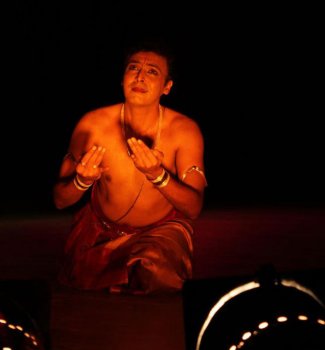 Vaibhav Arekar 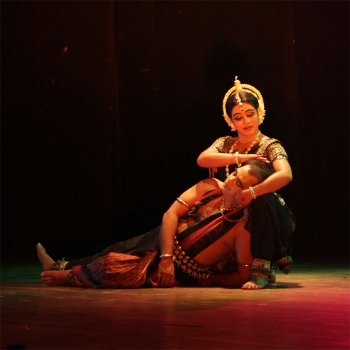 Srjan 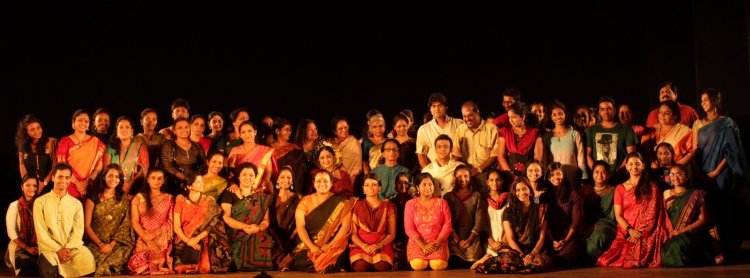 Kanak Rele felicitation group on stage After the shishya came the guru! Vaibhav honoured his guru Dr. Kanak Rele in a grand felicitation ceremony. An announcement welcoming the alumni of her school on stage had the stage packed to the brim with excited students and staff from Nalanda that enters its third decade. It was a reunion of sorts and all those on stage basked in the glory of Dr. Rele’s latest achievement, the Padma Bhushan award. Speaking on that occasion, she went down a nostalgic trip remembering her gurus, specially Guru Karunakar Panikker who mentored her. One must give credit to Dr. Rele for successfully mentoring hundreds of students into dance in a city like Mumbai. Her journey to success is a saga of inspiration to every dancer who wants to take to dance as a career fulltime. The evening continued into an assortment of pieces presented by Srjan from Bhubaneshwar. Under the guidance of Guru Ratikant Mohapatra, the Odissi dancers mesmerized everyone in the hall with their performance. After their famous ‘Bho Shambho’ piece on lord Shiva, the artistes of Srjan performed ‘Navadurga.’ Choreographed by Kelubabu with music composed by Harihara Panda and Ratikant on the mardala, there couldn’t have been a better tribute to the goddess during the famous Navaratras of Mumbai. The ashtabhuji or eight-armed Durga formation the dancers presented with such perfection resembled an ancient temple frieze. Various episodes were knit into the narration from the Durga Saptashati. The slaying of Shumbha Nishumbha (done with utmost grace by dancers Rinku Kumar Sahu and Sanjay Kumar Behara), the famous Mahishasura Mardhini, friezes of Vanadurga and other incarnations of the Devi increased the festive mood of the hall. Added to this was the brilliant lighting by everyone’s favourite Tikki (Debiprasad Misra). The third piece ‘Jatayu Moksha’ enacted by Bijayalakshmi Satpathy and Ratikant Mohapatra was yet another intense performance. Taking excerpts from Tulsidas’s ‘Ramcharitmanas’ and choreographing a whole sequence to bring about the right amount of pathos in the character of Jatayu, one could see the mastery of Kelubabu’s choreography. Though the piece did tend to get a little elongated, Ratikant’s portrayal of Jatayu’s loyalty to lord Rama was portrayed effectively. Srjan’s performance ended with ‘Biswas,’ a choreographed piece conveying the theme of communal harmony. Taking selections from all of India’s major religions and putting them together in an artistic way, the dancers of Srjan were successful in their effort. There couldn’t have been a better time and place to perform this particular piece. Mumbai with its communal disparities should see more of such performances that are done with such a genuine effort. Art heals the society which politics can’t and this choreographic masterpiece proved just that. The last day of the festival was a grand success with everyone eagerly awaiting the next edition. Until than we wish Vaibhav and his efficient team a hearty congratulations from all art lovers for bringing in yet another wonderful festival on to Mumbai’s cultural calendar. Veejay Sai is a writer, editor and a culture critic. |